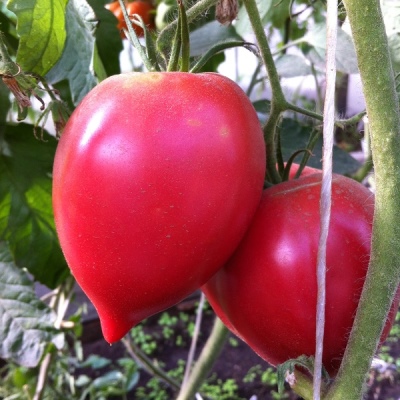
- Authors: Gonsiorovsky
- Category: grade
- Appointment: fresh consumption
- Ripening period: early
- Growing conditions: for open ground, for film greenhouses
- Bush size: medium-sized
- Bush height, cm: 150
- Bush characteristic: normal structure
- Ripe fruit color: pink-raspberry
- Fruit shape: heart-shaped
Among Siberian tomatoes, varieties from the Minusinsk Basin, distinguished by their strength of immunity, bright taste and aroma, are a separate category. Home hearts of the Gonsiorovskys are an indeterminate variety from the family collection of the Gonsiorovskys, whose seeds fully convey the quality of the parent plants. The tomato is intended for growing in open ground and in glass, film, polycarbonate greenhouses. The fruits of Home Hearts are used for fresh consumption, as well as for the preparation of juices, sauces, summer and winter salads.
Description of the variety
Medium-sized indeterminate bushes, from 150 cm in height, need to be formed and tied to a support or grown on a trellis.
The advantages of the variety:
- large-fruited;
- good productivity;
- excellent decorative and commercial properties;
- the variety has excellent taste.
Disadvantages of tomato:
- constant pinching is required;
- large-fruited does not allow whole-fruit canning.
Shoots are covered with drooping large leaves of a standard green color. Flowers are collected in simple inflorescences, on 3-5 or more clusters, form 3 to 5 ovaries.
The main qualities of the fruit
Large (300-600 g) fruits with a chiseled core are colored milky green when unripe. At the stage of technical and physiological ripeness, they acquire an intense pink-raspberry hue.
Taste characteristics
The dense, juicy, low-seeded fleshy pulp has a rich classic sweet taste with a pleasant sourness.
Ripening and fruiting
Homemade hearts are classified as early maturing varieties. At the same time, the yield of the crop has an extended period, which allows you to enjoy fresh tomatoes for a long time and slowly engage in conservation.
Yield
Home hearts of the Gonsiorovskys delight gardeners with good and stable yields - from one bush they collect from five and a half kilograms of fruits. Compliance with agrotechnical requirements allows you to count on higher rates.
The timing of planting seedlings and planting in the ground
Since the timing of planting young plants in a permanent place falls on days 60–65, the time of sowing seeds for seedlings depends on the climatic features of the area.

Growing tomato seedlings is an extremely important process, because it largely depends on whether the gardener will be able to harvest at all. All aspects must be taken into account, from seedbed preparation to planting in the ground.
Landing scheme
Experts advise not to place more than three roots per square meter.

Growing and care
Growing seedlings takes place in the traditional way:
- seed treatment with stimulants and disinfectants;
- initial cultivation in a greenhouse in a humid environment;
- hardening before planting in a permanent place in a greenhouse or vegetable garden.
A well-lit place is selected for growing tomatoes. The soil should be fertile, breathable, light and neutral in acidity. If necessary, it is deoxidized with bone or dolomite meal. In the fall, for digging, organic matter is introduced, preferably goat, sheep, horse manure. However, the most available is cow, which is also not bad - it is also rich in trace elements, vitamins. In the spring, fertilize with humus, bird droppings, compost.
Heavy loamy soils are not good for growing garden crops. Dense soil almost does not allow oxygen to pass through, so the ridges must be constantly loosened, and this is quite difficult. You can save yourself from this need by regularly sowing green manure, mulching, adding buckwheat or rice husks. The latter not only improve the structure of the soil, but also attract earthworms from the whole area, and this is an increase in the content of vermicompost, which is so necessary for the optimal development of crops.
After planting seedlings, care consists in organizing support, regular watering, weeding, forming a bush in 1-3 shoots, pinching, loosening and hilling, sanitizing.




A plant needs different micronutrients at each stage of growth. All fertilizers can be divided into two groups: mineral and organic. Folk remedies are often used: iodine, yeast, bird droppings, eggshells.
It is important to observe the rate and period of feeding. This also applies to folk remedies and organic fertilizers.
Disease and pest resistance
Tomato Home hearts Gonsiorovskih has average immunity. For him, late blight and apical rot, some other diseases characteristic of tomatoes, can be dangerous. In addition, like other nightshades, it is defenseless against the Colorado potato beetle, bear, naked slugs, can be attacked by thrips, aphids, whiteflies, spider mites.
All these indicators require preventive treatments with insecticides and fungicides several times per season. For those gardeners who do not recognize chemistry in their own plots, you can use folk remedies.


Resistant to adverse weather conditions
In the southern regions, the variety feels great outdoors, but in more northern regions it is better to grow it in greenhouses, since it is adversely affected by sharp nighttime cold snaps, drought and waterlogging, which is not uncommon in areas of risky farming.
Growing regions
The tomato shows excellent results throughout the country, since it was originally bred in the Siberian region.

























































































